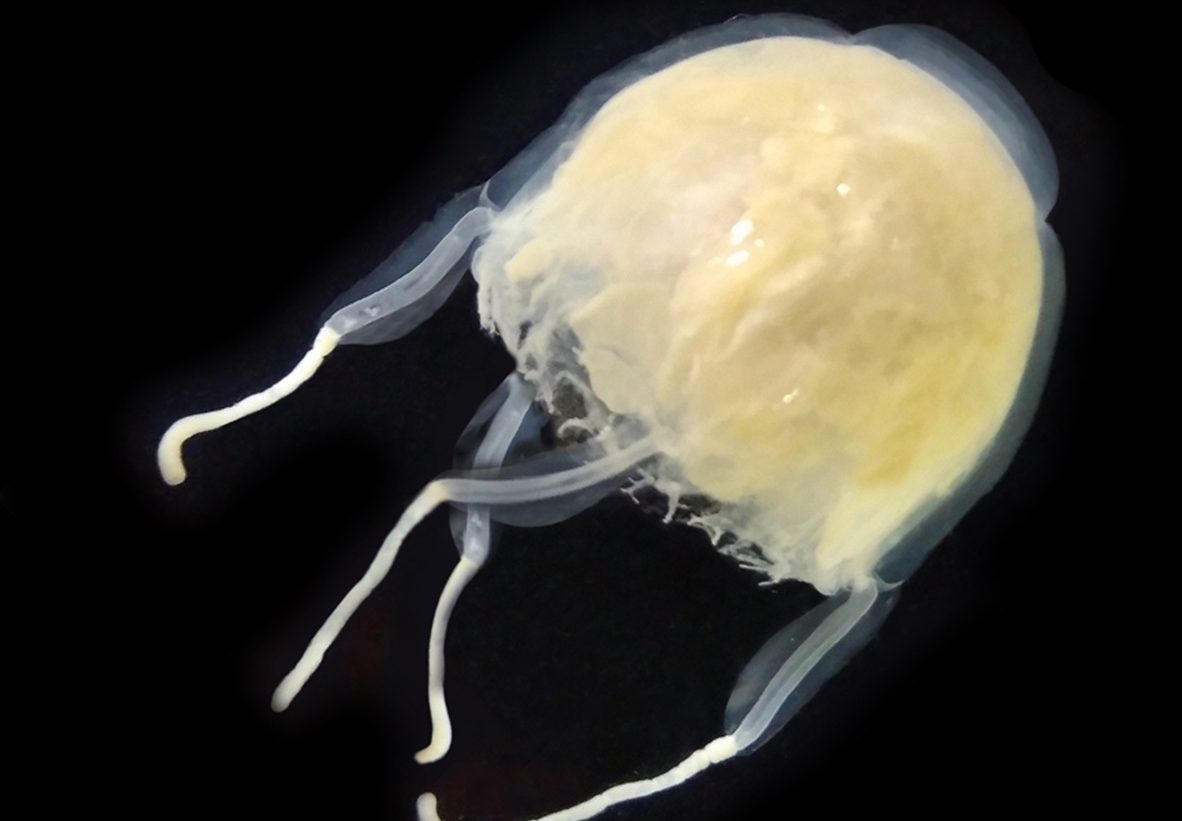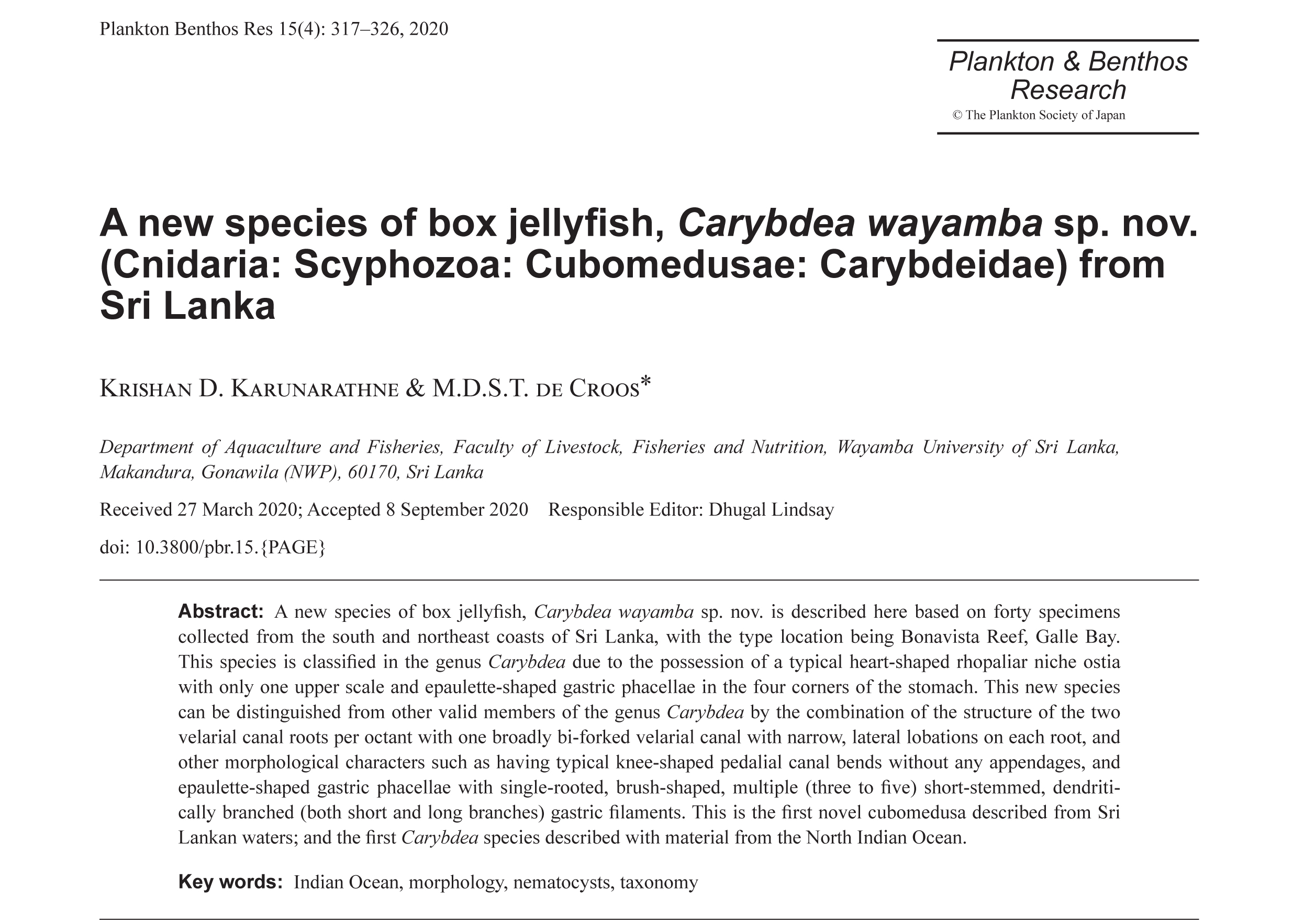Interviewed and written by Ramalka Kasige
We’ve mapped the world, discovered all the continents and sometimes it feels like there’s nothing new to look for on our little blue planet. But have you ever thought that Earth is still full of mysteries and surprises? Even as biodiversity around us is under threat or in retreat, scientists are discovering and naming new species at a greater rate than any time in history.
Scientists discovering new plant and animal species nearly every day and it proves that there are still adventures to be uncovered in the deep corners of the world. If you’ve ever harbored an ambition of being a zoologist or a botanist who would go in search of the new world, with the prime intention of the greater protection of species, then, your dream can still come true!
Fascinatingly, two Sri Lankan researchers have discovered a new box jellyfish species for the first time and the species is named Carybdea wayamba. This triumphant discovery was made by Mr. Krishan D Karunarathne (reading for Ph.D.), under the supervision of Dr. Dileepa de Croos of the Wayamba University of Sri Lanka. This article is based on an interview with the researchers.
- Let’s start with your study species; jellyfish. What’s so special about jellyfish? Freely swimming animals with gelatinous bodies are usually referred to as jellyfish, which comprise comb jellies (phylum Ctenophora); pelagic tunicates (phylum Chordata); and medusae (phylum Cnidaria). It is one of the poorly studied groups of marine fauna.
- We have always heard of jellyfish as a harmful, notorious species. What can you say about it? Yes, they are generally known to adversely affect the fishing industry, tourism, machinery, aquaculture, and marine biological surveys. Some jellyfish can also have ecosystem impacts, such as indirect effects on fisheries resources via predation of zooplankton, fish eggs, and ichthyoplankton, and as a vector for parasites by being invasive species worldwide. Not only cons, but a number of benefits are also provided by jellyfish in different ways. Let me share them with you; they are important to the stability of the marine ecosystem in nutrient cycling and symbiosis. Moreover, several species are exceptionally beneficial for human beings in various industries. Some species are harvested in mass quantities for human consumption while some are used in aquariums and zoos. Products derived from jellyfish have been used in livestock, agriculture, aquaculture, cosmetic industry, and pharmaceutical industry. Other than that, some jellyfish species are also used for environmental monitoring detection, fishing, and material science. Therefore, jellyfish are a very important species ecologically and socioeconomically.
- Can you give us a brief overview of the current diversity of jellyfish in Sri Lankan waters? Relating your question with the study results, there are about 50 species of jellyfish including 8 new species and 25 first records resulted from the present survey. With previous Sri Lankan records, altogether about 100 species of jellyfish were listed from this study for the first time.
- It seems that we harbor quite a lot of jellyfish around the island. What factors affect the populations of these animals? In general, jellyfish populations are considered to be increasing worldwide due to several reasons such as, eutrophication, overfishing, the introduction of alien species, setting up artificial substrates in the marine environments, and climate change. In this light, jellyfish cannot be considered as one of the vulnerable animal groups at present times.
- In such a context, what led to this study and discovery? In the recent past, Sri Lanka is known to export large quantities of processed jellyfish. However, by digging into the research history on jellyfish, we realized that no systematic study had been conducted for so long in estimating the diversity and population structures of jellyfish in Sri Lankan waters. So, with the support of the National Science Foundation (NSF) of Sri Lanka (Grant no: RG/2016/OMR/01), Wayamba University of Sri Lanka was able to conduct a research project focusing on generating core knowledge for sustainable utilization of local jellyfish resource. That is how the project was initiated.
- Moving on to a general question. What, exactly, do you mean when you refer to a “new species”? Well, this is a term that needs to be handled wisely. We have to be very careful as to what we mean by “new species” because a species we collect in a rural part of a country/world, which may be unknown to science and never been described or named by scientists, can be often very well known to the local people who live in that part of the country/world. A newly discovered species of organism to science is generally called a new species. Usually, a formal description of a new species should be published as a scientific paper. Its purpose is to give a clear description of a new species and explain how it differs from species that have been described previously or are related.
- So, what’s this new species identified in your study? Out of the few novel species identified in the study, one new box jellyfish species was published recently in an SCI journal. It is a mild stinger and belongs to the genus Carybdea. So far only about 50 species of box jellyfish have been reported over the world while the Sri Lankan box jellyfish is the first Carybdea species described in the entire North Indian Ocean. Also, it is the first-ever jellyfish species discovered by Sri Lankan researchers.
- What’s the story behind the name of the new species? The new species was named ‘Carybdea wayamba’ in honoring the Wayamba University of Sri Lanka because it is the very first animal species originally described at this institution.
- What is the outcome of your study? This study provides fundamental knowledge on the taxonomy, abundance, spatiotemporal distribution, occurrence related to environmental factors, and utility status of Sri Lankan jellyfish (pelagic forms of Cnidaria, Ctenophora, and Tunicata).
- What do you feel is the most challenging part of your study/discovery? It is a taxonomic identification. Jellyfish species have been overlooked in most of the marine biodiversity checklists and surveys of Sri Lanka because of the difficulty to identify them.
- So, what’s next (the next step)? At this point, the basic study has almost been done. But there’s a lot more to work on. So, looking forward to continuing the studies and the publish rest of the results soon. In my humble opinion, I feel that the researchers should pay further attention to carry out jellyfish aquaculture-, biology- and toxicology-related researches in the future.
- On a final note, what is the message you wish to share to our future zoologists/ marine biologists who wish to work on lower-level species (like jellyfish) in a tropical island like Sri Lanka? I should say that this field is a massive and inclusive field that has a huge scope. If we focus on marine invertebrate groups such as Cnidaria, Ctenophora, Porifera, and Tunicata, usually, identification and classification is the hardest task. Maybe there are less than 25 professional jellyfish taxonomists over the world, one or two experts from the Indian Ocean while nobody from Sri Lanka. So, there’s a lot of room and opportunity out there.
However, this study conducted with local research facilities proves you that, no matter what, taxonomic studying on lower-level fauna like jellyfish is not something impossible.
*****
Discovering a new species is not something that happens by chance, it requires prior knowledge, dedication, effort, time, money, manpower, and much more to make it happen. Both of these scientists and their team sacrificed a lot in discovering the species, before getting their research findings published. FOSmediaR team is, therefore, indeed thankful to Mr. Krishan D Karunarathne and Dr. Dileepa de Croos for sharing their story behind the discovery with us.
In a time of biodiversity decline, this discovery gives us hope that not all species are lost and that we have to protect not only the species but importantly the unique habitat that it inhabits and likely many other rare species’ homes.
- Read the Publication via, https://doi.org/10.3800/pbr.15.317





